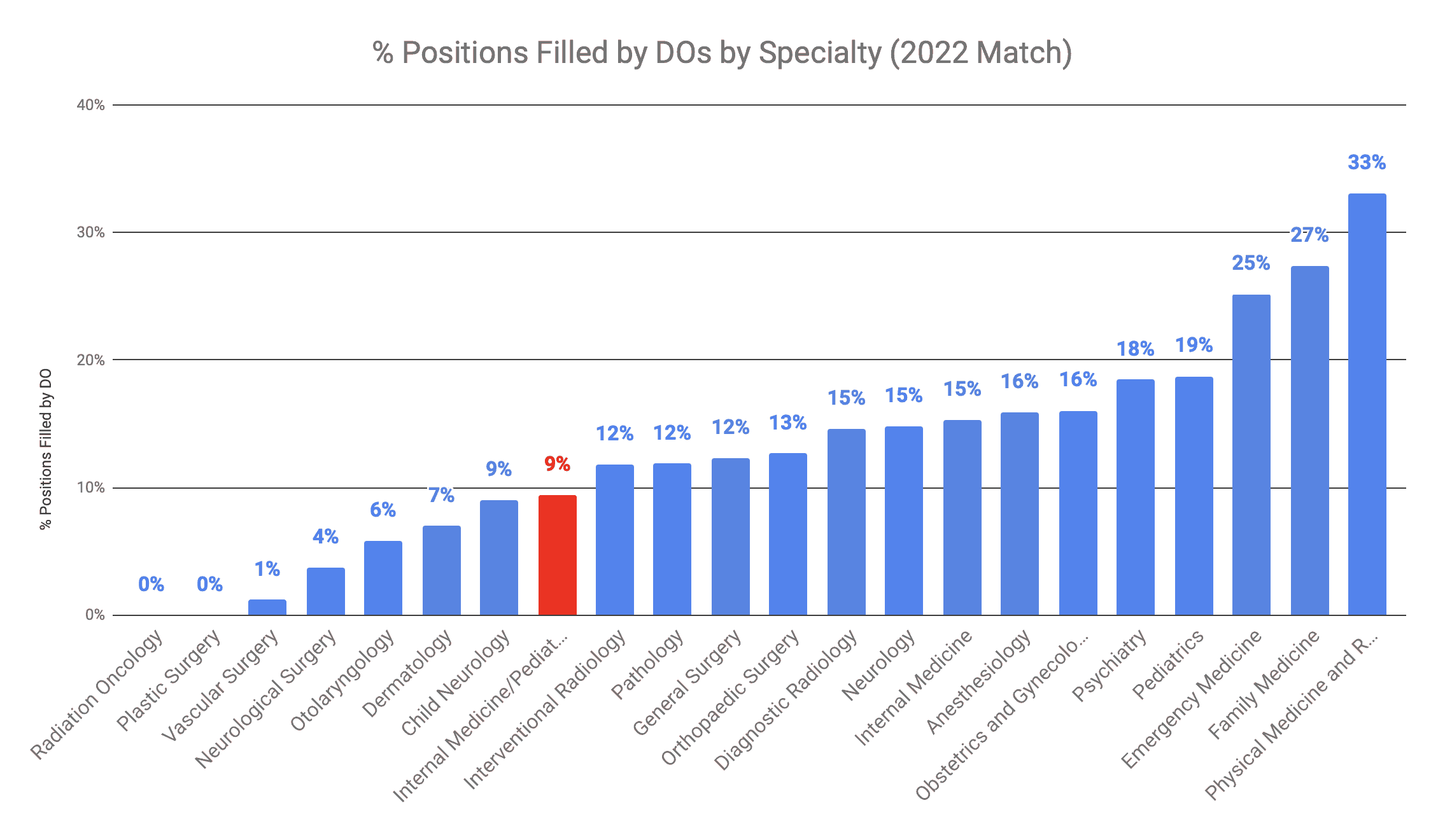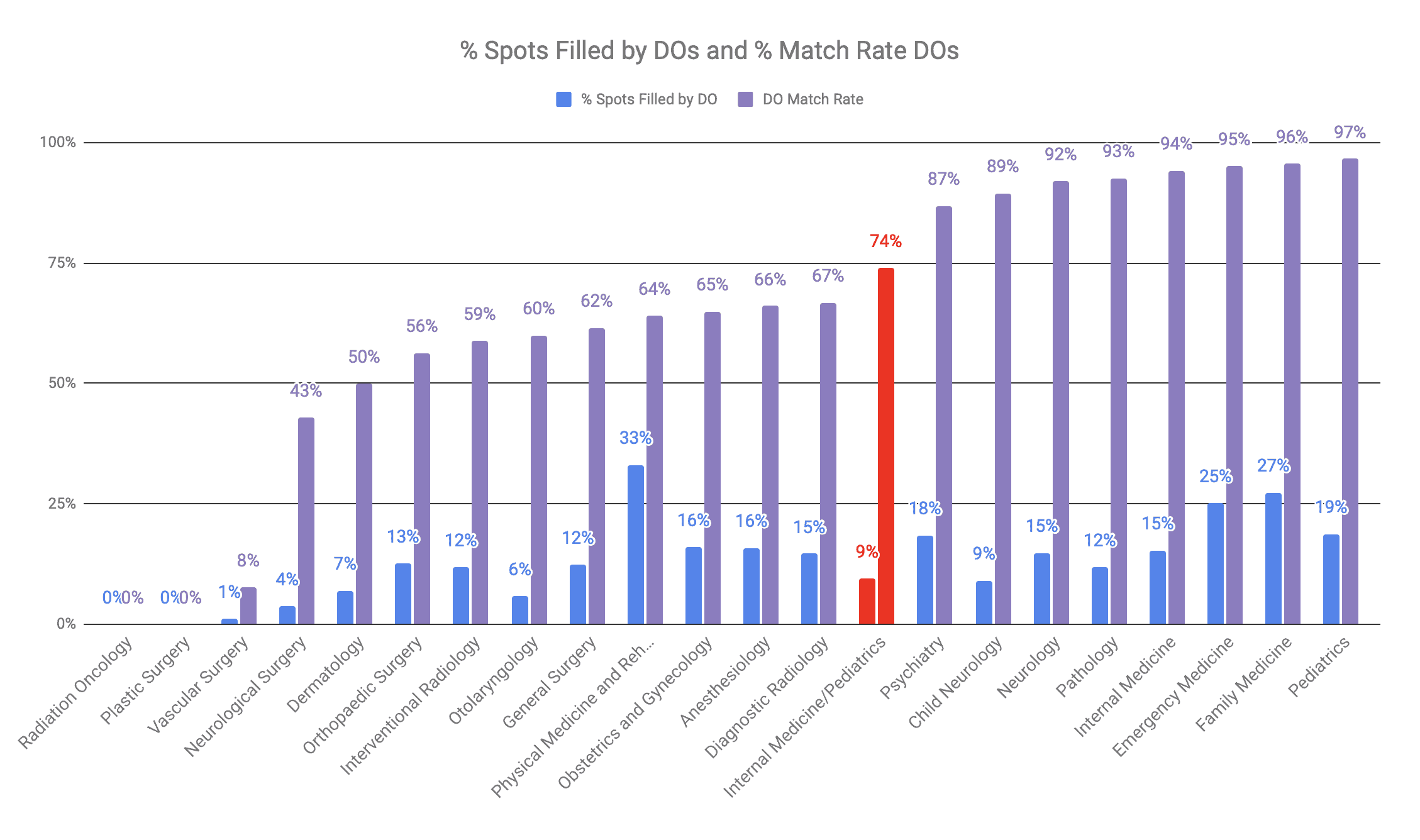
Are you wondering how DO-friendly (or unfriendly) internal medicine/pediatrics is as a US medical specialty? Do you want to know your chances of matching in this highly competitive field? Would you love to figure out what internal medicine/pediatrics programs a DO would stand the best chance?
This article will give you the most up-to-date information on DO-friendly internal medicine/pediatrics programs. Use this information to strategize on whether – and where – to apply to maximize your chances of matching as a DO in internal medicine/pediatrics.
Summary:
- Internal Medicine/Pediatrics is not a very DO-friendly US medical specialty. Despite having a high % of match rate, the % of spots filled by DOs is low
- There are a number of internal medicine/pediatrics residency matching programs that offer opportunities to DOs
- See the full list of searchable residency programs to strategize where DOs have recently been the most welcome
- Be sure to bookmark this page – and sign up for the newsletter – to keep up with the latest residency and USMLE trends and maximize your chances of matching
Table of Contents
What’s the Difference Between a DO and an MD?
Let’s start with some definitions.
DO: Doctor of Osteopathic Medicine
- Licensed physicians trained in “whole body” wellness and treatment techniques in muscle and joint manipulation in addition to mainstream treatments.
Allopathy Vs. Osteopathy
In the US, there are two main branches of registered physician:
- Allopathy: In this path, doctors train in modern, sometimes referred to as “Western”, medicine to treat symptoms and diseases. Doctors who train in this branch are licensed as Doctors of Medicine (MD)
- Osteopathy: These doctors have the same education and licensing exams as MDs but have additional training in muscle and joint manipulation. Doctors who train in Osteopathy are licensed as Doctors of Osteopathic Medicine (DO) and have the same residency training and choices as MDs.
COMLEX vs. USMLE
To begin practicing medicine, DOs and MDs must take specific licensing exams:
- COMLEX-USA: This test assesses osteopathic medical knowledge in addition to allopathic medical knowledge in order to become licensed as a DO in the USA.
- USMLE: This test assesses allopathic medical knowledge and is required to become licensed as an MD.
NRMP: “National Resident Matching Program®”
- The organization that administers the “Match.” In the match, the NRMP pairs residency applicants with a residency program.
Note that prior to the 2020 Match, DOs had access to a “pool” of residencies reserved for which only they could match. The current system has merged DO and MD residencies so that every applicant has the same “chance” for matching in their chosen specialty.
For more on how to maximize your match chances and how the “Merge” has changed residency applications, see THE MATCH: Everything You Need to Maximize Your Residency Chances
Internal medicine/Pediatrics is Not Very DO-Friendly
Looking at the % of spots filled by DOs in the 2022 Match, we can see internal medicine/pediatrics is not a very DO-friendly specialty. Only 9% of positions were filled by DOs:
Even though the percentage of spots filled by DOs was low, the match rate for this specialty was still above average at 74% in the 2022 match (74%):
Here are the same data represented in a table:
| % DO Applied that Matched | % DO Unmatched | % Positions Filled by DO | Total Positions Offered | Total # All Applicants | DO Senior Matched | DO Senior Unmatched | DO Senior Total | |
|---|---|---|---|---|---|---|---|---|
| **Radiation Oncology | 0% | 100% | 0% | 185 | 162 | |||
| **Plastic Surgery | 0% | 100% | 0% | 194 | 340 | |||
| Vascular Surgery | 8% | 92% | 1% | 84 | 143 | 1 | 12 | 13 |
| Neurological Surgery | 43% | 57% | 4% | 240 | 379 | 9 | 12 | 21 |
| Dermatology | 50% | 50% | 7% | 544 | 834 | 38 | 38 | 76 |
| Orthopaedic Surgery | 56% | 44% | 13% | 875 | 1,435 | 111 | 86 | 197 |
| Interventional Radiology | 59% | 41% | 12% | 169 | 226 | 20 | 14 | 34 |
| Otolaryngology | 60% | 40% | 6% | 361 | 556 | 21 | 14 | 35 |
| General Surgery | 62% | 38% | 12% | 1,622 | 2,400 | 200 | 125 | 325 |
| Physical Medicine and Rehabilitation | 64% | 36% | 33% | 532 | 725 | 176 | 99 | 275 |
| Obstetrics and Gynecology | 65% | 35% | 16% | 1,503 | 2,044 | 241 | 130 | 371 |
| Anesthesiology | 66% | 34% | 16% | 1,969 | 2,560 | 313 | 161 | 474 |
| Diagnostic Radiology | 67% | 33% | 15% | 1,155 | 1,568 | 169 | 84 | 253 |
| Internal Medicine/Pediatrics | 74% | 26% | 9% | 392 | 458 | 37 | 13 | 50 |
| Psychiatry | 87% | 13% | 18% | 2,047 | 2,560 | 378 | 57 | 435 |
| Child Neurology | 89% | 11% | 9% | 188 | 182 | 17 | 2 | 19 |
| Neurology | 92% | 8% | 15% | 1,014 | 1,249 | 150 | 13 | 163 |
| Pathology | 93% | 7% | 12% | 631 | 827 | 75 | 6 | 81 |
| Internal Medicine | 94% | 6% | 15% | 9,809 | 11,598 | 1,503 | 93 | 1596 |
| Emergency Medicine | 95% | 5% | 25% | 2,921 | 2,813 | 736 | 38 | 774 |
| Family Medicine | 96% | 4% | 27% | 4,916 | 5,055 | 1,345 | 62 | 1407 |
| Pediatrics | 97% | 3% | 19% | 3,016 | 3,153 | 565 | 20 | 585 |
For more on the most competitive DO medical specialties, see this article.
The Most DO-Friendly Internal Medicine/Pediatrics Residency Programs
As the data from the most recent GME census shows, even though most internal medicine/ pediatrics residency programs do not favor DOs, some programs are more likely to fill spots with DOs. For example, two internal medicine/pediatrics residency programs had DO percentages higher than 50%: Vidant (54%) and Geisinger (50%). Additionally, two had DO rates of 30% or higher: The University of Illinois (36%) and Penn State Milton S Hershey (31%).
Here is a list of the most (and least) competitive internal medicine/pediatrics programs for DOs. It includes data from the most recent National GME Census Survey. Percentages are of all residents in the program in 2020.
| Specialty: Internal Medicine/Pediatrics | ||||||||||
|---|---|---|---|---|---|---|---|---|---|---|
| ACGME residency program code | Residency program name | City | State | % residents US DO graduates | % residents US MD graduates | Osteopathic Recognition | # applications submitted (2021 NRMP Main Match) | % applicants interviewed (2020 NRMP Main Match) | # of positions offered (2021 NRMP Main Match) | # of positions (2021 NRMP Main Match) |
| 7003632057 | Vidant Medical Center/East Carolina University Program | Greenville | NC | 54 | 33 | No | 245 | 29.1 | 6 | 6 |
| 7004114068 | Geisinger Health System Program | Danville | PA | 50 | 30 | No | 241 | 32.5 | 5 | 5 |
| 7001632015 | University of Illinois College of Medicine at Peoria Program | Peoria | IL | 36 | 58 | No | 277 | 37.8 | 9 | 9 |
| 7004132081 | Penn State Milton S Hershey Medical Center Program | Hershey | PA | 31 | 69 | No | 236 | 28.2 | 4 | 4 |
| 7003832061 | The MetroHealth System/Case Western Reserve University Program | Cleveland | OH | 29 | 58 | No | 528 | 28.4 | 6 | 6 |
| 7005532080 | West Virginia University Program | Morgantown | WV | 29 | 65 | No | 175 | 24.7 | 3 | 3 |
| 7000914009 | Sidney Kimmel Medical College at Thomas Jefferson University/Christiana Care Health Services Program | Newark | DE | 24 | 76 | No | 240 | 23.6 | 5 | 5 |
| 7002832036 | University of Missouri-Kansas City School of Medicine Program | Kansas City | MO | 22 | 78 | No | 197 | 25.7 | 6 | 6 |
| 7005632096 | Medical College of Wisconsin Affiliated Hospitals Program | Milwaukee | WI | 21 | 79 | No | 285 | 40.4 | 6 | 6 |
| 7002714035 | University of Mississippi Medical Center Program | Jackson | MS | 16 | 84 | No | 168 | 35.1 | 5 | 5 |
| 7001014129 | MedStar Health/Georgetown University Hospital Program | Washington | DC | 13 | 88 | No | 357 | 4 | 4 | |
| 7001614014 | Loyola University Medical Center Program | Maywood | IL | 13 | 87 | No | 297 | 26.9 | 4 | 4 |
| 7003014136 | University of Nebraska Medical Center College of Medicine Program | Omaha | NE | 13 | 81 | No | 176 | 34.6 | 4 | 4 |
| 7003514044 | Albany Medical Center Program | Cohoes | NY | 13 | 81 | No | 270 | 32.8 | 4 | 4 |
| 7001132125 | University of South Florida Morsani Program | Tampa | FL | 12 | 88 | No | 195 | 18.1 | 5 | 5 |
| 7004814075 | University of Texas Health Science Center at Houston Program | Houston | TX | 9 | 84 | No | 295 | 22.9 | 8 | 8 |
| 7003500106 | Icahn School of Medicine at Mount Sinai Program | New York | NY | 8 | 83 | No | 285 | 4 | 4 | |
| 7003532093 | Stony Brook Medicine/University Hospital Program | Stony Brook | NY | 8 | 83 | No | 254 | 25.3 | 3 | 3 |
| 7002832126 | University of Missouri-Columbia Program | Columbia | MO | 7 | 33 | No | 498 | 28.2 | 4 | 4 |
| 7004732071 | University of Tennessee Program | Memphis | TN | 7 | 93 | No | 233 | 36.1 | 14 | 14 |
| 7005132077 | Virginia Commonwealth University Health System Program | Richmond | VA | 7 | 93 | No | 256 | 33.5 | 4 | 4 |
| 7003532049 | University at Buffalo Program | Buffalo | NY | 6 | 65 | No | 223 | 19.7 | 4 | 4 |
| 7003832121 | Case Western Reserve University/University Hospitals Cleveland Medical Center Program | Cleveland | OH | 6 | 94 | No | 313 | 12.5 | 4 | 4 |
| 7001114086 | University of Miami/Jackson Health System Program | Miami | FL | 5 | 95 | No | 300 | 19.4 | 5 | 5 |
| 7003814082 | University of Cincinnati Medical Center/College of Medicine Program | Cincinnati | OH | 4 | 96 | No | 366 | 24.1 | 7 | 7 |
| 7003532054 | University of Rochester Program | Rochester | NY | 3 | 97 | No | 265 | 35.2 | 8 | 8 |
| 7002614034 | University of Minnesota Program | Minneapolis | MN | 2 | 98 | No | 268 | 41 | 10 | 10 |
| 7000532130 | UCLA David Geffen School of Medicine/UCLA Medical Center Program | Los Angeles | CA | 0 | 100 | No | 228 | 17.9 | 4 | 4 |
| 7000814127 | Yale-New Haven Medical Center Program | New Haven | CT | 0 | 100 | No | 266 | 18.7 | 4 | 4 |
| 7001614012 | University of Chicago Program | Chicago | IL | 0 | 100 | No | 332 | 23.4 | 4 | 4 |
| 7001614013 | University of Illinois College of Medicine at Chicago Program | Chicago | IL | 0 | 93 | No | 338 | 30.1 | 4 | 4 |
| 7003332040 | Rutgers Health/New Jersey Medical School Program | Newark | NJ | 0 | 100 | No | 263 | 26.9 | 4 | 4 |
| 7003614056 | Duke University Hospital Program | Durham | NC | 0 | 100 | No | 347 | 24.1 | 6 | 6 |
| 7003632055 | University of North Carolina Hospitals Program | Chapel Hill | NC | 0 | 100 | No | 337 | 20.7 | 6 | 6 |
| 7003814063 | Ohio State University Hospital Program | Columbus | OH | 0 | 100 | No | 319 | 30.6 | 10 | 10 |
| 7004114128 | UPMC Medical Education Program | Pittsburgh | PA | 0 | 100 | No | 302 | 15.3 | 4 | 4 |
| 7004114129 | University of Pennsylvania Health System Program | Philadelphia | PA | 0 | 100 | No | 333 | 16.3 | 6 | 6 |
| 7004314108 | Brown University Program | Providence | RI | 0 | 100 | No | 262 | 22 | 4 | 4 |
| 7004514135 | Prisma Health/University of South Carolina SOM Greenville (Greenville) Program | Greenville | SC | 0 | 100 | No | 201 | 31.6 | 5 | 5 |
| 7004532127 | Medical University of South Carolina Program | Charleston | SC | 0 | 100 | No | 252 | 23.4 | 4 | 4 |
| 7004714070 | Vanderbilt University Medical Center Program | Nashville | TN | 0 | 100 | No | 332 | 24.7 | 6 | 6 |
| 7004800114 | University of Texas Southwestern Medical Center Program | Dallas | TX | 0 | 100 | No | 282 | 21.1 | 4 | 4 |
| 7004814074 | Baylor College of Medicine Program | Houston | TX | 0 | 100 | No | 325 | 28.7 | 9 | 9 |
| 7004914091 | University of Utah Health Program | Salt Lake City | UT | 0 | 100 | No | 185 | 21.6 | 3 | 3 |
| 7000132085 | USA Health Program | Mobile | AL | No | 131 | 32.3 | 3 | 3 | ||
| 7002532030 | Hurley Medical Center/Michigan State University Program | Flint | MI | No | 313 | 20.5 | 3 | 3 | ||
| 7002532033 | Beaumont Health (Royal Oak) Program | Royal Oak | MI | No | 322 | 20 | 4 | 4 | ||
| 7003932067 | University of Oklahoma School of Community Medicine (Tulsa) Program | Tulsa | OK | No | 0 | 0 | 0 | |||
| 7003932090 | University of Oklahoma Health Sciences Center Program | Oklahoma City | OK | No | 241 | 14.2 | 3 | 3 | ||
| 7004232145 | University of Puerto Rico School of Medicine Program | San Juan | PR | No | 47 | 14.9 | 2 | 2 | ||
| 7005532079 | Marshall University School of Medicine Program | Huntington | WV | No | 305 | 20.8 | 2 | 2 | ||
| 7005614109 | Marshfield Clinic Program | Marshfield | WI | No | 218 | 19.1 | 2 | 2 |
Concluding Thoughts
Internal Medicine/Pediatrics is not very DO-friendly. While the match rate is high at 74%, the percentage of positions filled by DOs is low. Most internal medicine/pediatrics matching programs do not favor DOs. That said, there are still opportunities for DOs to pursue this specialty for the top applicants. For instance: two programs had a DO rate higher than 50% and two had a rate higher than 30%.
Are you despairing at your chances of matching into internal medicine/pediatrics as a DO? Then, check out Never Forget, where you can learn how to master – not memorize – for the impressive USMLE scores to match at your dream residency. And if you’re looking for a residency advisor, look at our residency advisory services.









